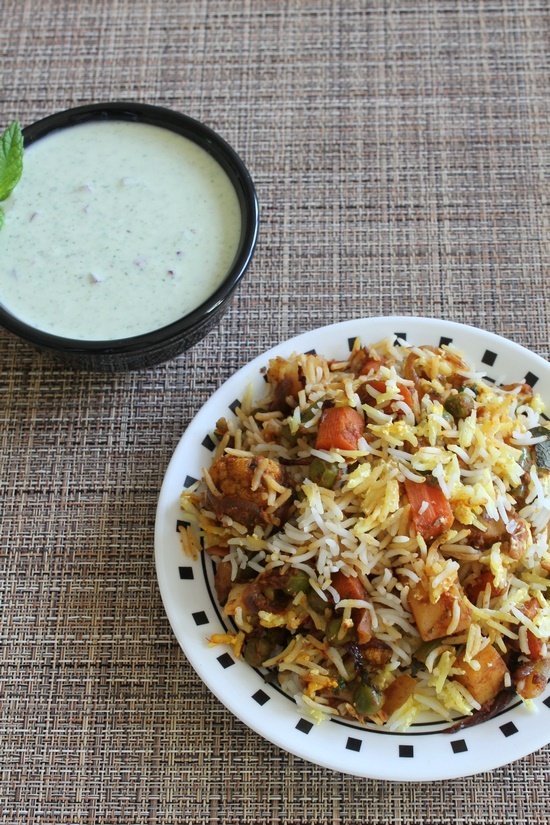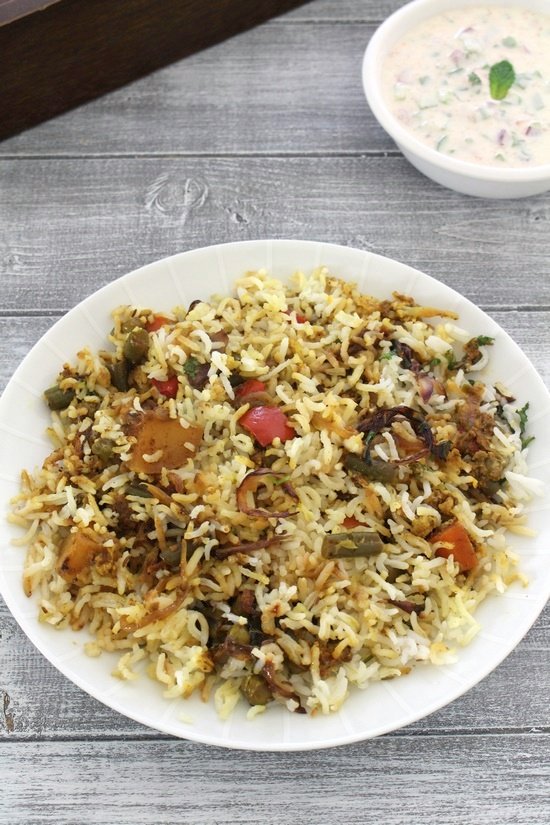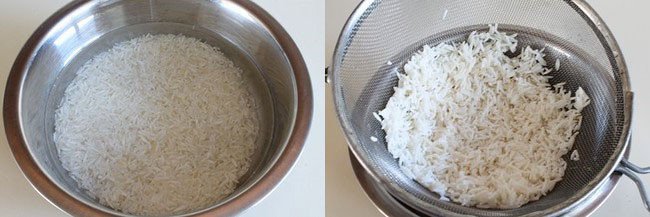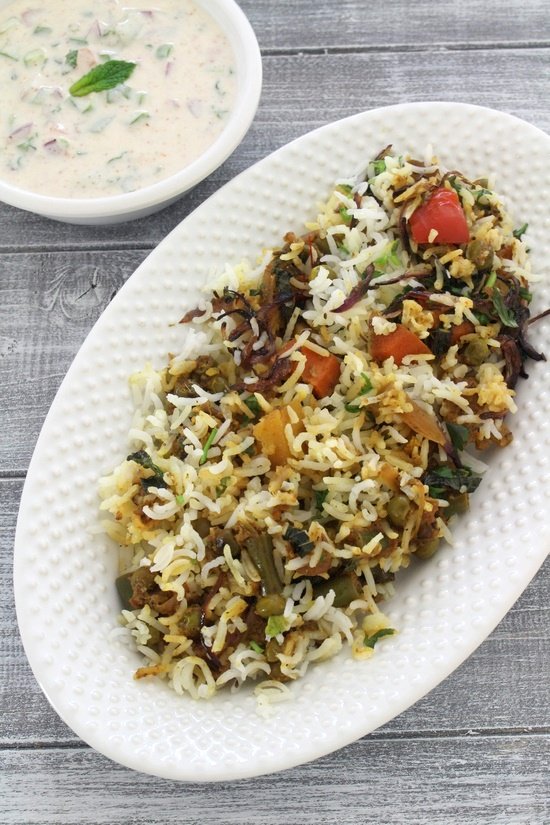Veg Biryani is a rich and aromatic rice delicacy that traces its roots to the regal heritage of Hyderabad. Unlike pulao, which is a simpler rice preparation, biryani is more elaborate, layered, and infused with bold, aromatic flavors. This meatless masterpiece combines aromatic basmati rice, a flavorful medley of spiced vegetables, and the traditional slow-cooking dumpling method.

What Makes Veg Biryani Special?
To prepare traditional Veg Biryani, both the rice and the mixed vegetables are cooked partially and separately. The partially cooked rice and vegetable masala are arranged in layers inside a deep pot, one over the other. Each layer is enhanced with fried onions, golden cashews, saffron-infused yogurt, and fresh herbs like mint and coriander. The finishing step is the “dum” process — a gentle, sealed, slow-cooking method that allows all the layered flavors to meld beautifully.
Eventually, when you open the lid, the beautifully spiced aroma fills the air, making everyone at the table crave a bite. Trust us — it’s worth every minute.
Why Is It Called Dum Biryani?
The word dum refers not to the Veg Biryani itself, but to the unique cooking style used. Known as dum pukht, this method involves sealing the pot to trap steam and cook the ingredients slowly in their own juices. Traditionally, the pot was placed on hot coal embers, with more embers added on the lid to ensure even heating from both sides.
At home, we replicate this process by placing the sealed pot on a stovetop over low heat or baking it in the oven. The moisture inside the pot turns to steam, gently cooking the biryani while blending the rice, vegetables, spices, and herbs into a beautifully unified dish.
Opening the Pot: The Moment of Magic
The true magic of dum Veg Biryani lies in that moment when you break the seal. The steam carries with it a medley of aromas — earthy, spicy, and floral — that immediately transport you to the kitchens of Hyderabad. At the table, the biryani should be served by gently scooping out portions that include both the spiced rice and the flavorful vegetables from each layer.
Regional Variations of Veg Biryani
While this version is based on the Hyderabadi tradition — arguably the most iconic biryani style in India — many regions have their own interpretations. From the slightly sweet Kolkata-style biryani to the spicy Chettinad variation from Tamil Nadu, every region offers a unique twist. We’ll explore these in upcoming posts, so stay tuned.
Tips for Making the Perfect Veg Biryani

Use high-quality basmati rice: Long, fragrant grains that stay fluffy after cooking are key.
Don’t skip the saffron: Soaking saffron in warm milk or yogurt gives the rice a beautiful hue and deep floral aroma.
Cook rice al dente: Rice should be about 70% cooked before layering to avoid overcooking during dum.
Use fresh ingredients: Especially when it comes to herbs and whole spices, freshness makes a big difference in flavor.
Seal it well: Whether you use dough or a tight-fitting lid, ensuring no steam escapes is essential for proper dum cooking.
Veg Biryani isn’t just food — it’s an experience that delights the senses. Whether it’s a festive celebration, a family get-together, or a quiet weekend indulgence, this dish adds a touch of warmth and grandeur to any occasion. As you get the hang of the method, you’ll be drawn back to it often, each attempt more delicious than the one before.
Let the kitchen come alive with irresistible aromas, the spices weave their magic, and every bite earns you heartfelt compliments!
Ingredients For Veg Biryani:
For Cooking the Rice:
- 1 cup Basmati Rice – Choose premium-quality, aged long-grain basmati rice for a fluffy texture and rich aroma. Rinse thoroughly and soak for about 30 minutes to ensure even cooking and prevent breakage.
- 4 cups Water – To parboil the rice; adjust if needed based on rice variety.
- 2 Green Cardamoms (Elaichi) – Add a subtle, sweet fragrance to the rice.
- 2 Black Cardamoms (Badi Elaichi) – Provides a deep, smoky aroma characteristic of biryani.
- 4 Cloves (Laung) – Brings warm, pungent notes to the cooking water.
- 4-5 Black Peppercorns – Adds a gentle hint of spice.
- 1 inch Cinnamon Stick (Dalchini) – Gives a sweet and woody flavor to the rice.
- One Bay Leaf – Introduces a subtle, earthy aroma and enhances the depth of the masala.
- 1 teaspoon Cumin Seeds (Jeera) – Tempered in hot oil to unlock their warm, nutty essence.
- 1½ teaspoons Ginger Paste or Freshly Grated Ginger – Brings a sharp, slightly sweet heat that brightens the dish.
- Salt to Taste – Enhances flavor and seasons the rice evenly.
For Fried Onions & Nuts:
- 2-3 tablespoons Oil or Ghee – Used for frying onions and nuts; ghee adds richness.
- 3 tablespoons Cashew Nuts – Adds a delicious crunch and buttery flavor to the biryani layers.
- 2 tablespoons Almonds – Use sliced, chopped, or whole, as preferred. Toasted almonds add texture.
- 1 small Red Onion or ½ cup, Thinly Sliced – Fry until golden brown for birista; essential for authentic biryani flavor.
For Vegetable Gravy (Masala Base):
- 1–2 tablespoons Oil or Ghee – Use any neutral cooking oil or aromatic ghee to sauté the whole spices and vegetables for added depth of flavor.
- 2 Green Cardamoms – Infuses the base with a gentle aroma.
- 4–5 Cloves – Infuse the dish with a warm, slightly sweet spice that enhances the overall complexity.
- 1-inch Cinnamon Stick – Adds a sweet-spicy aroma and deep, woody flavor to the masala base.
- 1 Bay Leaf – Adds a classic touch of flavor.
- 1 teaspoon Cumin Seeds (Jeera) – Sizzled in oil to release their nutty aroma.
- 1½ teaspoons Ginger Paste or Freshly Grated Ginger – Adds a zesty, warm flavor.
- 1½ teaspoons Garlic Paste or Freshly Crushed Garlic – Brings a sharp and pungent taste to the masala.
- 2 Green Chilies, Slit – Adjust based on spice preference.
- 1 medium Red Onion or ¾ cup, Thinly Sliced – Sauté until soft and translucent.
- 1 medium Carrot or ½ cup, Diced – Adds color and natural sweetness.
- 8-10 Green Beans or ½ cup, Cut into 1-inch pieces – Contributes a slight crunch and freshness.
- ½ cup Cauliflower Florets – Blanch beforehand to ensure even cooking.
- ⅓ cup Green Capsicum (Optional) – Adds a hint of sweetness and texture; can be skipped.
- 1 medium Potato or ¾ cup, Peeled and Cubed – Adds substance and richness to the dish.
- ½ cup Green Peas – Use fresh or frozen; adds a pop of color and sweetness.
- Salt to Taste – Season the vegetables generously.
- 2-3 teaspoons Red Chili Powder – Adjust to taste for heat and color.
- ½ teaspoon Turmeric Powder – Adds a golden hue and mild earthy bitterness that balances the spices.
- 2 teaspoons Coriander Powder – Adds a gentle, citrusy depth.
- 1 teaspoon Garam Masala or Biryani Masala – Use homemade or store-bought; this gives the main flavor.
- 2 teaspoons Kasuri Methi (Dried Fenugreek Leaves) – Crush between palms before adding for maximum aroma.
- 1 medium Tomato or ½ cup, Pureed – Adds slight tanginess and helps bind the masala.
- 2 tablespoon Fresh Coriander Leaves, Finely Chopped – Enhances freshness and aroma.
- 1 tablespoon Fresh Mint Leaves, Finely Chopped – A key herb in biryani for cooling, refreshing notes.
For Layering & Final Assembly:
- ⅓ cup Plain Yogurt (Dahi or Curd) – Whisked until smooth; used between layers for richness and flavor.
- A few strands of Saffron – Steep in warm milk for 10–15 minutes to release its rich color and delicate floral fragrance, perfect for layering.
- 2-3 teaspoons Warm Milk – Used to infuse saffron and spread over rice layers.
- 1 teaspoon Rose Water – Optional, but adds a beautiful floral note. Kewra water can be used as an alternative.
- 2 teaspoons Ghee (Clarified Butter) – Drizzle on top before sealing the pot for enhanced aroma.
- 2-3 tablespoons Mint Leaves, Roughly Chopped – Added between layers for freshness and flavor lift.
Step-by-Step Instructions:
Preparing the Rice:
1) Rinse the Basmati Rice
Thoroughly wash 1 cup of basmati rice under cold running water until the water turns clear. This helps remove excess starch. Soak the rice in ample water for at least 20–30 minutes.
2) Drain the Soaked Rice
After soaking, drain the rice using a strainer or colander and set it aside.

3) Prep While Rice Soaks
While the rice is soaking, begin chopping all the vegetables and prepare the tomato puree. (Note: You may see chopped tomatoes in some images, but a puree is used later.)
4) Get the Whole Spices Ready
Separate the whole spices needed for both the rice and the veggie gravy, so everything is on hand. (Star anise may be missing in some images.)

Parboiling the Rice:
1) Boil the Water
In a large pot, bring 4 cups of water to a rolling boil over high heat. Once boiling, add the whole spices: green and black cardamoms, cloves, peppercorns, cinnamon stick, mace, bay leaf, star anise, and salt to taste.
2) Add Rice
Now, add the soaked and drained rice to the boiling water.

3) Cook Until 80% Done
Let the rice cook for about 5 minutes. The grains should be about 80% cooked, firm with a slight bite in the center.
4) Drain and Rinse
Quickly drain the rice and rinse it with cold water to stop it from cooking any further.

5) Spread the Rice
Evenly spread the drained rice on a large plate or tray to let it cool and prevent the grains from sticking together. This step helps to prevent the grains from sticking together.
6) Discard the Spices
Remove and discard the whole spices from the parboiled rice before layering.

Frying Onions and Nuts For Veg Biryani:
1) Fry the Onions
Warm 2–3 tablespoons of oil in a pan over medium flame until it’s hot and ready for frying. Add thinly sliced onions and fry until golden brown and crispy. Be careful not to burn them. Remove to a paper towel-lined plate.

2) Fry the Nuts
In the same oil, lightly fry the cashew nuts and almonds until golden. Remove and set aside.

Cooking the Vegetables For Veg Biryani:
1) Sauté Whole Spices
In the same pan (add a little more oil if needed), heat 2–3 teaspoons of oil. Toss in green cardamoms, cloves, a piece of cinnamon stick, and a bay leaf to infuse the oil with their aromatic flavors. Sauté briefly until fragrant.
2) Add Cumin Seeds
Toss in cumin seeds and let them crackle.

3) Add Aromatics
Now add ginger paste, garlic paste, and slit green chilies. Sauté for a minute or two until the spices release their fragrance and the raw aroma fades away.
4) Add Chopped Veggies
Stir in the chopped onion, carrots, beans, cauliflower, potatoes, and green peas.

5) Mix Well
Combine the veggies and sauté for a few minutes.
6) Add Spices
Season with salt, red chili powder, turmeric, coriander powder, biryani masala or garam masala, and crushed kasuri methi.

7) Blend Everything
Give everything a good stir, making sure the vegetables are evenly covered in the spice mixture.
8) Add Tomato Puree
Pour in the tomato puree and mix thoroughly.

9) Cook Until Veggies Are ¾ Done
Cover and cook until the vegetables are nearly cooked but still have a slight bite (about 75% done).
10) Add Fresh Herbs
Mix in chopped mint and coriander leaves, give it a final stir, and turn off the heat.

11) Prepare Saffron Milk
In a small bowl, combine warm milk with saffron strands. Warm it gently to help the saffron release its vibrant color and rich fragrance.

Making the Yogurt Mixture:
1) Combine Ingredients
Mix the saffron-infused milk with plain yogurt, and stir in a dash of rose water or kewra water if desired, for added aroma.
2) Whisk and Set Aside
Start by spreading one-third of the cooked rice as the base layer in the pot.

Layering the Veg Biryani:
1) Grease the Bottom of the Pot
Spread 2 teaspoons of ghee at the bottom of the thick-bottomed pan to prevent sticking and to enhance flavor.
2) Start Layering
Begin with one-third of the cooked rice at the bottom.
3) Add Veggie Masala
Spread half of the cooked vegetable mixture over the rice.
4) Add Another Layer of Rice
Then, spread the second layer by adding another one-third of the rice evenly over the spiced vegetables.
5) Add Toppings
Drizzle half of the saffron-yogurt mix over the rice, then top with half of the golden fried onions and roasted nuts.

6) Final Veg Layer
Spread the remaining vegetable gravy on top.
7) Last Rice Layer
Top with the final portion of rice.
8) Finish with Garnishes
Pour the remaining yogurt mixture over the top layer, then scatter the rest of the fried onions and toasted nuts evenly. Garnish with roughly chopped mint leaves.

Dum Cooking on Stovetop:
1) Seal the Pot
- Choose your preferred sealing method:
- Cover with a clean kitchen towel and place a tight-fitting lid.
- Or cover with foil and then the lid.
(Traditional method uses dough to seal the edges, but it’s optional.)
2) Use a Tawa for Gentle Heat
Preheat a flat tawa (griddle) over medium heat. Reduce the flame to low and place the biryani pot over it. This ensures indirect heat and prevents burning.
3) Slow Cook for 15–20 Minutes
Let the biryani cook on low flame for 15 to 20 minutes, allowing the flavors to marry through steam.

4) Rest Before Serving
After cooking, let the biryani rest for 5 minutes before opening. This helps the layers settle and the steam to distribute evenly.
5) Serve and Enjoy
Gently scoop from the bottom, making sure every serving has both rice and vegetables. Serve hot with raita, salad, or papad.

Serving suggestion For Veg Biryani:
Pair your flavorful veg dum biryani with a refreshing raita like mint, cucumber, boondi, or mixed vegetable raita to balance the spices. Add a side of crispy roasted papad for a satisfying crunch. For a heartier meal, serve it alongside a rich salan or spiced shorba-style curry.

